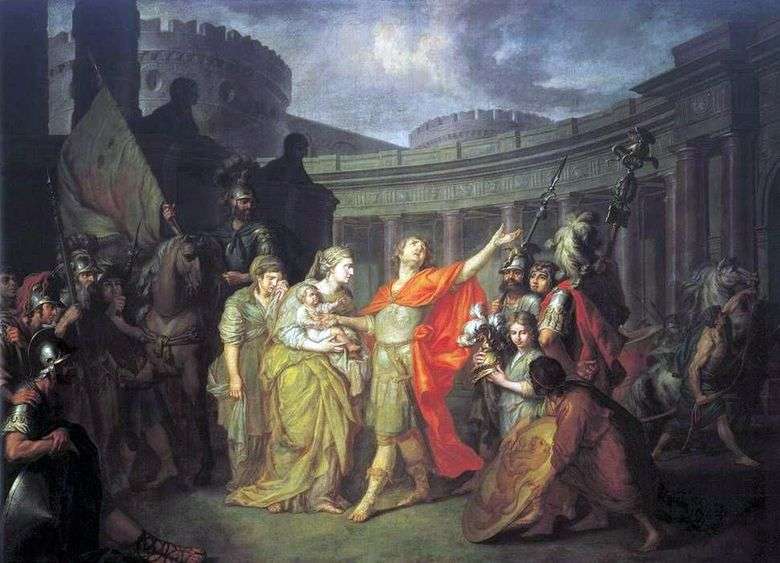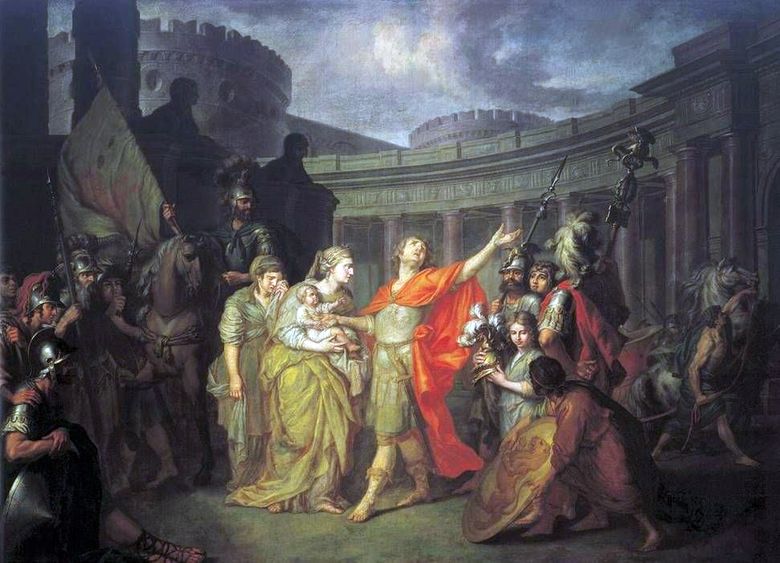
In 1773, Losenko began, but did not manage to finish his second historical picture – “Hector’s Farewell to Andromache”; this partly explains some sketchiness in the pictorial interpretation of images.
Antique story from the Iliad of Homer glorified the heroes, their patriotic feelings, and their willingness to sacrifice themselves to the service of their homeland. These ideals of educational classicism, to which the artist was faithful throughout his entire creative life, received a vivid expression in the “Hector farewell”.
The action takes place at the city gate. The hero of Troy, the son of the Trojan king Priam, Hector says goodbye, before the duel with Achilles, with his faithful wife Andromache, who holds the infant in her arms. Anticipating his doom, he asks for the patronage of the gods and prays for his son to grow wise, brave and glorious. A sense of civic duty in the soul of Hector overcomes personal feelings of affection for the family. The image of Hector is endowed with the heroic traits of the ideal hero – this is a courageous and steadfast warrior, noble in his thoughts.
A premonition of a tragic outcome permeates the pathetic scene presented by the artist. However, only the main character, Hector, is genuinely pathetic. In the images of the remaining characters, Losenko connects a restrainedly stately and naturally harsh beginning, harmoniously organizing the composition and the hot color of the picture.
Majestic architecture enhances its heroic sound. Despite the well-known conventionality and theatricality peculiar to the historical painting of the classical style, the work of Losenko is full of dramatic action and imbued with high civic pathos.
 La despedida de Héctor a Andrómache – Anton Losenko
La despedida de Héctor a Andrómache – Anton Losenko Les adieux d’Hector à Andromaque – Anton Losenko
Les adieux d’Hector à Andromaque – Anton Losenko Andromache at the body of Hector by Jacques Louis David
Andromache at the body of Hector by Jacques Louis David Vladimir and Rogneda by Anton Losenko
Vladimir and Rogneda by Anton Losenko Hector invites Paris to the battle by Angelika Kaufman
Hector invites Paris to the battle by Angelika Kaufman Cain by Anton Losenko
Cain by Anton Losenko Abraham sacrifices his son Isaac (Abraham’s Sacrifice) by Anton Losenko
Abraham sacrifices his son Isaac (Abraham’s Sacrifice) by Anton Losenko Captured Andromache by Fredekik Leighton
Captured Andromache by Fredekik Leighton